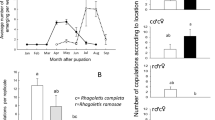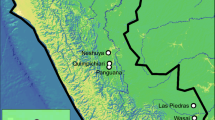Abstract
The typological concept of rotifer species and the morphological basis of rotifer systematics is reviewed and alternatives proposed. Occasional sexuality in the cyclical parthenogenetic life cycle of monogononts permits application of the biological species concept to this group. Data from cross-mating experiments with Asplanchna, Brachionus and Epiphanes illustrate the usefulness of reproductive isolation as a criterion for species boundaries. Populations from different geographic regions are often interfertile indicating that rotifer species are genetically integrated over wide areas. The main types of isolating mechanisms operating in monogononts are reviewed. The role of behavioral reproductive isolation in maintaining species boundaries is examined. The use of a mate recognition bioassay which estimates the probability of copulation and quantifies the degree of isolation is described. Recent work of the mechanism of mate recognition is reviewed. It is concluded that the biological species concept is applicable to rotifers and that a more experimental approach to determining species boundaries is both feasible and desirable.
Similar content being viewed by others
References
Birky, C. W., Jr. & J. J. Gilbert, 1971. Parthenogenesis in rotifers: The control of sexual and asexual reproduction. Amer. Zool. 11: 245–266.
Birky, C. W., Jr., 1967. Studies on the physiology and genetics of the rotifer Asplanchna. III. Results of outcrossing, selfing and selection. J. exp. Zool. 165: 104–116.
Bogdan, K. G. & J. J. Gilbert, 1987. Quantitative comparison of food niches in some freshwater zooplankton. Oecologia 72: 331–340.
Carlin, B., 1943. Die Planktonrotatorien des Motalastrom. Medd. Lunds Univ. Limnol. Institut., 258 pp.
Clement, P., E. Wurdak & J. Amsellem, 1983. Behavior and ultrastructure of sensory organs in rotifers. Hydrobiologia 104: 89–130.
Dobzhansky, T., 1970. Genetics of the Evolutionary Process. Columbia University Press, New York, 505 pp.
Giddings, L. V. & A. R. Templeton, 1983. Behavioral phylogenies and the direction of evolution. Science 220: 372–378.
Gilbert, J. J., 1963. Contact chemoreceptors, mating behavior and reproductive isolation in the rotifer genus Brachionus. J. Exp. Biol. 40: 625–641.
Gilbert, J. J., C. W. Birky, Jr. & E. S. Wurdak, 1979. Taxonomic relationships of Asplanchna brightwelli, A. intermedia and A. sieboldi. Arch. Hydrobiol. 87: 224–242.
Hauser, C. L., 1987. The debate about the biological species concept — a review. Z. zool. Syst. Evolut.-forsch. 25: 241–257.
Hebert, P. D. N., 1987. Genotypic characteristics of the cladocera. Hydrobiologia 145: 183–193.
Hertel, E. W., 1942. Studies on vigor in the rotifer Hydatina senta. Physiol. Zool. 15: 304–324.
Holman, E. W., 1987. Recognizability of sexual and asexual species of rotifers. Systematic Zoology 36: 381–386.
Hutchinson, G. E., 1967. A Treatise on Limnology. Volume 2. Introduction to Lake Biology and Limnoplankton. John Wiley & Sons, New York, 1115 pp.
Hutchinson, G. E., 1981. When are species necessary? In: Population Biology and Evolution, R. C. Lewontin (ed.), Syracuse University Press, Syracuse, NY: 177–186.
King, C. E. & T. W. Snell, 1980. Density-dependent sexual reproduction in natural populations of the rotifer Asplanchna girodi. Hydrobiologia 73: 149–152.
King, C. E., 1977. Genetics of reproduction, variation, and adaptation in rotifers. Arch. Hydrobiol. Beih. 8: 187–201.
Lambert, D. M. & H. E. H. Paterson, 1983. On bridging the gap between race and species: The isolation concept and an alternative. Proc. linn. Soc. N.S.W. 107: 501–514.
Littlejohn, M., 1981. Reproductive isolation: a critical review. In: Evolution and Speciation, W. R. Atchley & D. S. Woodruff (eds.), Cambridge University Press, Cambridge: 298–334.
Mayr, E., 1963. Animal Species and Evolution. Belknap Press, Harvard University, Cambridge, MA.
Mayr, E., 1970. Populations, Species and Evolution. Belknap Press, Harvard University, Cambridge, MA.
Mayr, E. 1981. Biological classification: Toward a synthesis of opposing methodologies. Science 214: 510–516.
Miracle, M., M. Serra, E. Vicente & C. Blanco, 1987. Distribution of Brachionus species in Spanish mediterranean wetlands. Hydrobiologia 147: 75–81.
Nei, M., T. Maruyama & C. Wu, 1983. Models of evolution of reproductive isolation. Genetics 103: 557–579.
Nevo, E. & R. R. Capranica, 1985. Evolutionary origin of ethological isolation in cricket frogs, Acris. Evol. Biol. 19: 147–214.
Paterson, H. E. H., 1978. More evidence against speciation by reinforcement. S. African J. Science 74: 369–371.
Paterson, H. E. H., 1980. A comment on ‘mate recognition systems’. Evolution 34: 330–331.
Paterson, H. E. H., 1982. Perspectives on speciation by reinforcement. S. African J. Science 78: 53–57.
Paterson, H. E. H., 1985. The recognition concept of species. In: Species and Speciation, E. S. Vrba (ed.), Transvaal Museum Monograph No. 4, Transvaal Museum, Pretoria, Rep. S. Africa: 21–29.
Pejler, B., 1956. Introgression in planktonic Rotatoria with some points of view on its causes and conceiveable results. Evolution 10: 246–261.
Pejler, B., 1977a. General problems on rotifer taxonomy and global distribution. Arch. Hydrobiol. Beih. 8: 212–220.
Pejler, B., 1977b. On the global distribution of the family Brachionidae (Rotatoria). Arch. Hydrobiol. Beih. Supplement 2: 255–306.
Ruttner-Kolisko, A., 1963. The interrelationships of the Rotatoria. In: The Lower Metazoa, E. C. Dougherty, (ed.), Univ. Calif Press, Berkeley, Calif: 263–272.
Ruttner-Kolisko, A., 1969. Kreuzungexperimente zwischen Brachionus urceolaris and Brachionus quadridentatus, ein Beitrag zur Fortpflanzungbiologie der heterogonen Rotatoria. Arch. Hydrobiologie 65: 397–412.
Ruttner-Kolisko, A., 1974. Plankton Rotifers. Binnengewasser 26 suppl.: 1–146.
Ruttner-Kolisko, A., 1983. The significance of mating processes for the genetics and for the formation of resting eggs in monogonont rotifers. Hydrobiologia 104: 181–190.
Ruttner-Kolisko, A., 1985. Results of individual cross-mating experiments in three distinct strains of Brachionus plicatilis (Rotatoria). Verh. int. Ver. Limnol. 22: 2979–2982.
Ryan, M. J. & W. Wilczynski, 1988. Coevolution of sender and receiver: Effect on local mate preference in cricket frogs. Science 240: 1786–1788.
Shull, A. F., 1911. Studies in the life cycle of Hydatina senta. II. The role of temperature, of chemical composition of the medium, and of internal factors on the ratio of parthenogenetic to sexual forms. J. exp. Zool. 10: 117–166.
Shull, A. F., 1915. Inheritance in Hydatina senta. IV. Characters of females and their parthenogenetic eggs. J. exp. Zool. 18: 145–186.
Snell, T. W. & C. A. Hawkinson, 1983. Behavioral reproductive isolation among populations of the rotifer Brachionus plicatilis. Evolution 37: 1294–1305.
Snell, T. W. & F. H. Hoff, 1987. Fertilization and male fertility in the rotifer Brachionus plicatilis. Hydrobiologia 147: 329–334.
Snell, T. W., M. J. Childress & B. C. Winkler, 1988. Characteristics of the mate recognition factor in the rotifer Brachionus plicatilis. Comp. Biochem. Phys. 89A: 481–485.
Snell, T. W. & M. A. Nacionales, 1989a. Sex pheromone communication in Brachious plicatilis (Rotifera). Submitted.
Snell, T. W. & M. A. Nacionales, 1989b. Localization of the mate recognition glycoprotein on the rotifer Brachionus plicatilis. Submitted.
Templeton, A. R., 1987. Species and speciation. Evolution 41: 233–235.
Thornhill, R. & J. Alcock, 1983. The Evolution of Insect Mating Systems. Harvard University Press, Cambridge, MA.
Van Valen, L., 1982. Integration of species: Stasis and biogeography. Evol. Theory 6: 99–112.
Wallace, R. L. & R. A. Colburn, 1989. Phylogenetic relationships within the phylum Rotifera: orders and genus Notholca. Hydrobiologia 186/187: 311–318.
Author information
Authors and Affiliations
Rights and permissions
About this article
Cite this article
Snell, T.W. Systematics, reproductive isolation and species boundaries in monogonont rotifers. Hydrobiologia 186, 299–310 (1989). https://doi.org/10.1007/BF00048925
Issue Date:
DOI: https://doi.org/10.1007/BF00048925




